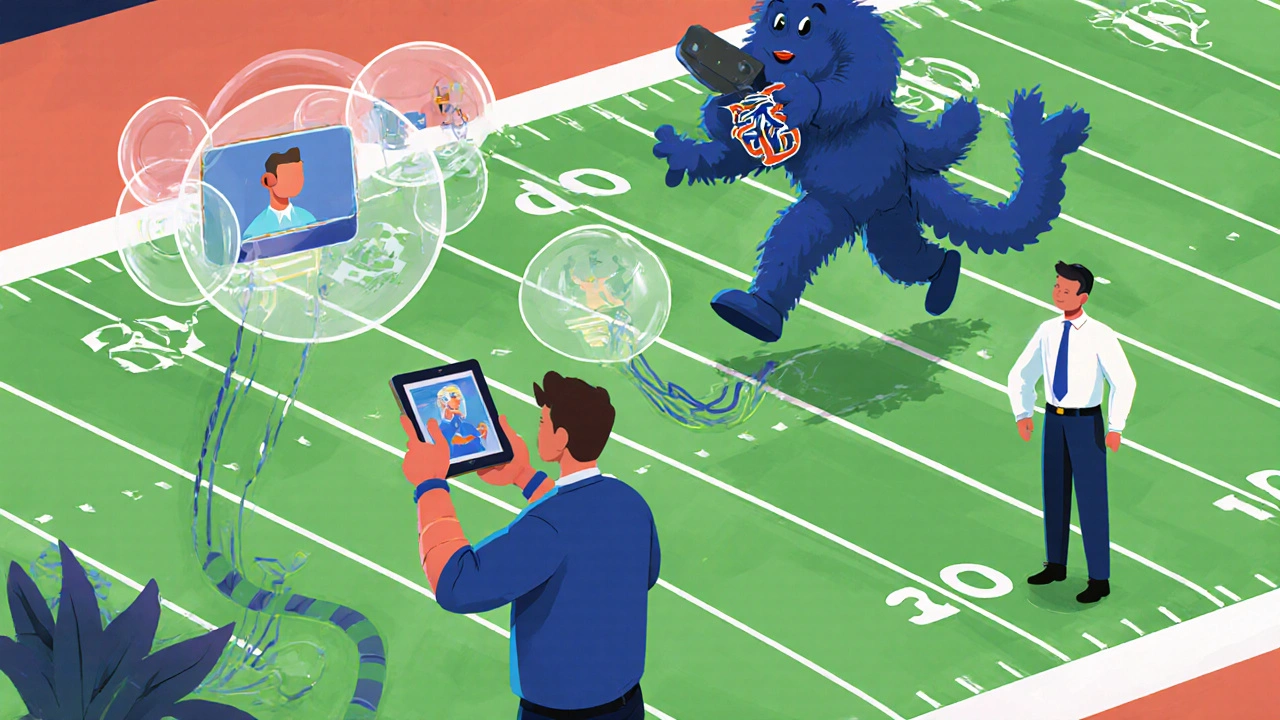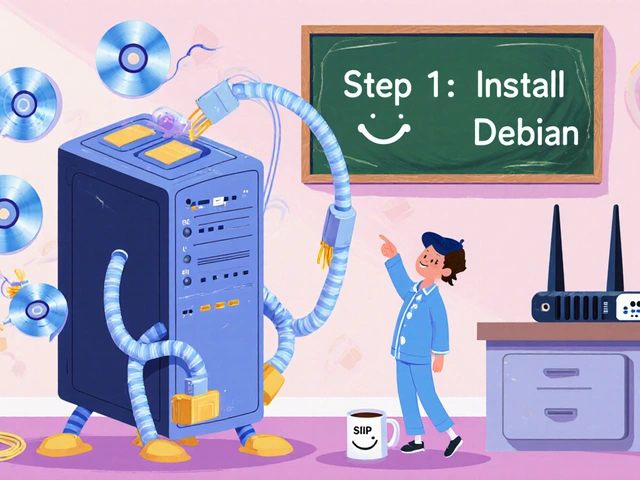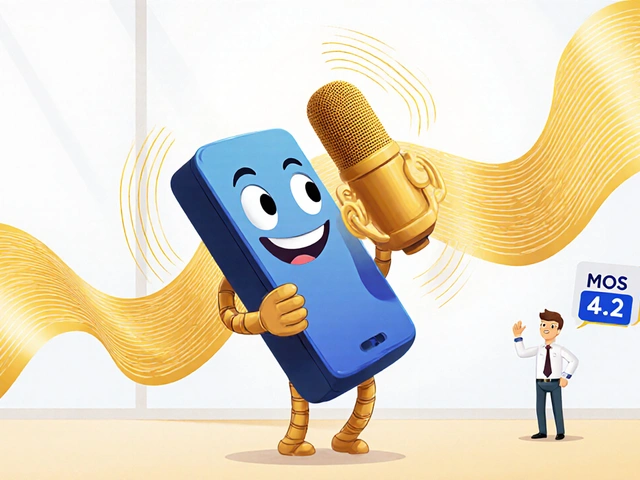Imagine a packed stadium on a Friday night. The crowd roars as the home team scores. In the control room, a technician spots a power fluctuation near Section 212. Within seconds, a wireless beltpack alert goes out to maintenance. At the same time, a fan in the upper deck orders a hot dog through their phone, and it’s delivered to their seat in under three minutes. Meanwhile, the coach on the sideline gets a live feed of the opponent’s formation from the broadcast booth-all without a single traditional phone line.
This isn’t science fiction. It’s what happens when sports teams and venues use VoIP (Voice over Internet Protocol) systems the right way. No more clunky landlines, no more buried cables, no more missed calls because someone’s in the locker room. VoIP turns communication into a dynamic, mobile, and intelligent tool that keeps operations running smoothly and fans feeling connected-even when they’re not watching the game live.
Why Traditional Phone Systems Fail in Sports Venues
Old-school phone systems were built for offices, not stadiums. They rely on physical wiring, fixed desks, and long-term contracts. In a sports venue, staff are constantly on the move: trainers sprinting between locker rooms, security patrolling parking lots, concessions staff rushing to refill stands, and event managers juggling last-minute changes. A phone that only works at one desk is useless.
And the contracts? Most traditional telecom providers lock venues into 2- to 3-year deals. That’s a problem when your budget shifts every season, your staffing changes after a playoff run, or a new sponsor wants to roll out a digital campaign on short notice. One golf course operator in Wisconsin switched from a legacy system after paying $48,000 over three years-only to realize they were overpaying for unused lines in storage rooms and maintenance sheds. After switching to a VoIP provider with month-to-month plans, they cut their monthly bill by 40% and gained full control over who got which feature.
Traditional systems also can’t scale. If you add 500 seats to your arena, you’re not just adding phones-you’re running new copper lines, hiring electricians, and waiting weeks for installation. With VoIP, you plug in a phone anywhere there’s network access, and it’s live. No rewiring. No downtime. No surprises.
How VoIP Keeps Sports Venues Running Smoothly
Behind every great game is a team of people working silently to make sure nothing goes wrong. VoIP makes that possible.
At major stadiums, communication isn’t just about making calls-it’s about survival. FIFA’s technical guidelines list critical zones that must have reliable voice connectivity: delivery compounds where equipment arrives, car park barriers where traffic flows, emergency lifts, and refuge points for evacuations. These aren’t optional. They’re life-safety requirements.
Modern VoIP systems handle this with wireless beltpacks, IP-enabled intercoms, and remote stations. Clear-Com’s Digital Partyline system, for example, lets staff in the tunnel, the press box, and the control room talk instantly-even if they’re 800 feet apart. No more shouting into walkie-talkies or waiting for radio signals to cut out.
And it’s not just emergencies. Daily operations rely on seamless communication. A vendor shows up with 200 cases of bottled water? The logistics team pages the warehouse via VoIP app. The mascot needs a new costume before halftime? The costume manager gets a direct call from the dressing room. The head coach needs to speak with the front office during a timeout? He picks up his desk phone from his sideline tablet.
VoIP also supports multi-site operations. A team with a training facility 20 miles from the stadium? Same phone system. Same extension. Same voicemail. Staff can move between locations without reprogramming devices. That kind of flexibility used to cost six figures in hardware and IT setup. Now, it’s built into the subscription.
Turning Fans Into Participants, Not Just Spectators
People don’t just go to games for the action on the field. They go for the experience. And VoIP is now the backbone of that experience.
Uniguest’s Sports Hub lets venues deliver live game footage, real-time stats, sponsor ads, and even food ordering to screens throughout the building-concourses, restrooms, suites, and even hotel rooms connected to the venue’s network. All of this runs over the same IP network that carries voice calls. No separate systems. No extra cables. No conflicting tech teams.
Think about this: a fan in a luxury suite opens an interactive portal on their tablet. They see a live feed of the game, a menu of premium snacks, and a button to order a bottle of champagne. Two minutes later, it’s delivered by a staff member who was paged via VoIP and is now navigating the crowd using a digital map on their phone. That’s not magic. That’s VoIP + IPTV + mobile apps working together.
Even the scoreboard is smarter now. Instead of just showing the score, it can pull live social media feeds, countdown timers to the next quarter, weather updates, and even trivia questions that fans can answer via their phones. All of it syncs with the venue’s central communication system. The result? Fans stay longer. They spend more. They come back.
According to Verizon’s 2023 report, smart stadiums are growing at 22% per year and will hit $23.3 billion by 2028. Why? Because venues that use technology to deepen fan engagement outperform those that don’t. And VoIP is the glue that holds it all together.

VoIP vs. CATV: The Real Choice for Video in Venues
Many venues still use CATV (Community Access Television) to broadcast live games and replays on TV screens. It’s simple: coaxial cable, one-way signal, easy to install. But it’s also outdated.
IPTV (Internet Protocol Television), delivered over the same IP network as VoIP, is the future. It’s not just about better picture quality-it’s about control. With IPTV, you can show different content to different zones. VIP suites get live TV and exclusive interviews. Concourses get sponsor promotions and real-time stats. Staff areas get training videos and safety alerts. All from one system.
And here’s the kicker: IPTV uses the same bandwidth as VoIP. You don’t need two networks. You don’t need two IT teams. You don’t pay for two sets of equipment. Media Links estimates that a 1080p video stream uses 3 Gbps-same as 500 simultaneous VoIP calls. Modern switches handle both without breaking a sweat.
While CATV might be cheaper upfront, IPTV saves money long-term. Why? Because you can update content remotely. No truck rolls. No technicians climbing ceilings. Just a click in a browser. Uniguest’s clients manage everything-from scoreboards to sponsor ads-through a single dashboard. That’s efficiency.
Cost Savings That Actually Matter
Let’s talk numbers. A typical mid-sized arena spends $15,000 to $25,000 a year on phone service with a legacy provider. That includes monthly fees, maintenance contracts, and hardware replacements every five years.
Switching to a modern VoIP system cuts that by 30-60%. Why? Because:
- You pay only for the lines you use-no more paying for unused phones in storage closets.
- There are no long-term contracts. You can scale up or down month to month.
- Hardware costs drop because phones work over existing network cables (PoE-Power over Ethernet).
- IT support costs shrink since everything is managed remotely.
One minor league baseball team in Ohio saved $18,000 in the first year after switching. They used the savings to install free Wi-Fi for fans and upgrade their digital scoreboards. Attendance jumped 12% the next season.
And when emergencies happen-power outages, network hiccups-reliable VoIP systems have built-in redundancy. If one server fails, another kicks in. If the main internet line drops, the system switches to a backup cellular connection. That kind of reliability used to cost $50,000 in backup generators. Now, it’s included in the monthly fee.

What to Look for in a VoIP Provider for Sports
Not all VoIP systems are built for stadiums. Here’s what to ask:
- Can staff use phones anywhere? Look for systems that support mobile apps, wireless beltpacks, and plug-and-play desk phones.
- Is there redundancy? Ask about automatic failover to cellular or backup internet. No downtime during games is non-negotiable.
- Can it integrate with video and digital signage? If the provider can’t connect to IPTV, scoreboards, or fan apps, you’re paying for half a solution.
- Do they offer month-to-month pricing? Avoid any provider that forces a 2-year contract. The sports industry changes too fast.
- Is 24/7 support included? Emergencies don’t wait for business hours. Make sure support is in-house, not outsourced overseas.
Top providers like Uniguest, AgileIP, and c2cvoip serve over 300 sports and entertainment venues. They’ve built their systems around real-world problems: loud environments, mobile staff, emergency protocols, and fan-facing tech. Don’t settle for a generic business VoIP plan. You need a system designed for the chaos of a live event.
The Future Is Integrated
What’s next? Private 5G networks inside stadiums. AI-powered voice assistants that answer fan questions via app. Real-time translation for international visitors. Facial recognition for VIP access-all running on the same IP backbone.
Imagine Communications reported at the 2024 NAB Show that IP is now the default choice for new sports venue builds. Why? Because it’s the only system that can handle voice, video, data, and automation on one network. The days of separate phone lines, TV cables, and Wi-Fi routers are over.
Teams and venues that stick with old tech will struggle to compete-not just for fans, but for revenue. The best stadiums aren’t just places to watch games anymore. They’re immersive experiences. And VoIP is the invisible engine making it all possible.









allison berroteran
31 Oct 2025 at 18:49It’s wild to think how much of the stadium experience is now just invisible infrastructure-like the air we breathe. We don’t notice the VoIP system until it fails, and then suddenly, everything stops: the hot dog doesn’t arrive, the coach can’t reach the front office, the emergency alert gets delayed. It’s not just about convenience anymore; it’s about human connection in a space designed for collective emotion. That fan ordering food from their seat? That’s not a gimmick-it’s a quiet act of belonging. The venue isn’t just selling tickets anymore, it’s selling presence, continuity, and care. And all of it runs on packets of data, not copper wires. I wonder if future historians will look back at this era and call it the Quiet Revolution-the moment sports stopped being about the game and started being about the ecosystem around it.